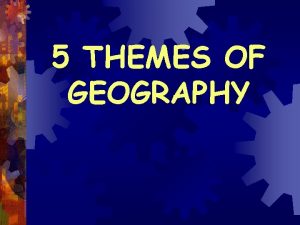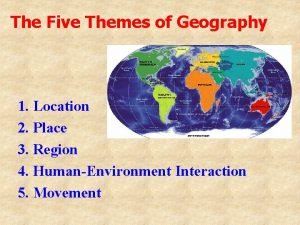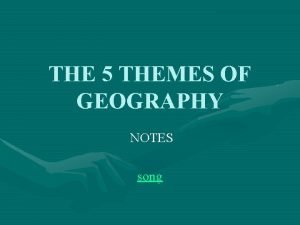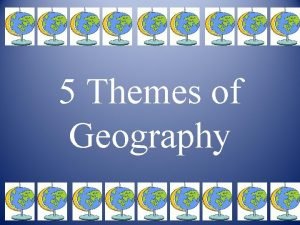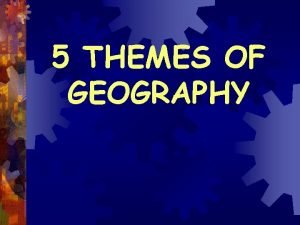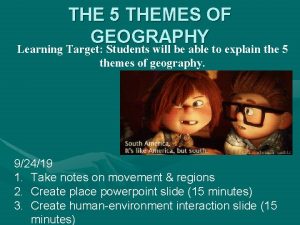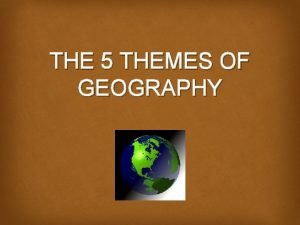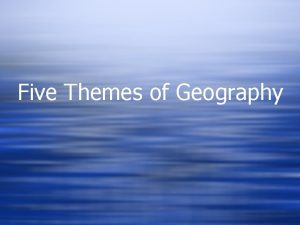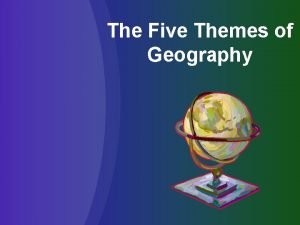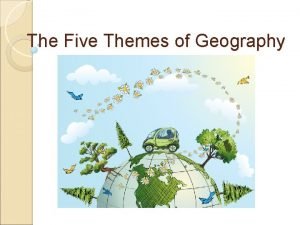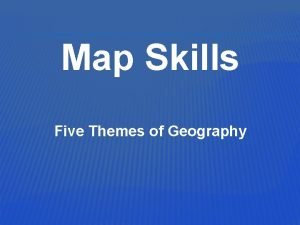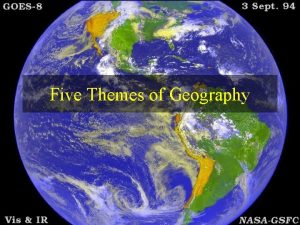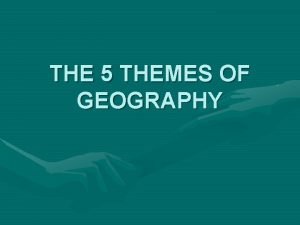The Five Themes of Geography What is Geography













- Slides: 13

The Five Themes of Geography

What is Geography? ● Geography is the study of the physical features of the earth and its atmosphere (and also of human activity as it affects and is affected by these) ● Geographers are concerned with asking three important questions about things in the world: 1. Where is it? 2. Why is it there? 3. What are the consequences of its being there?

The Five Themes of Geography Help Answer These Questions… ● Location: ○ Where is it located? ● Place: ○ What's it like there? ● Human/Environment Interaction: ○ What is the relationship between humans and their environment? ● Movement: ○ How and why are places connected with one another? ● Regions: ○ How and why is one area similar to another? Each theme is connected to all of the other themes.

Location: Position on Earth’s Surface ● Absolute and relative location are two ways of describing the positions and distribution of people and places on the earth's surface ● Absolute Location answers the question: Where is it? ● Latitude and Longitude can be used to pinpoint a location ● Relative Location is the relationship of a place to other places

Location ● Location is only one piece of the framework of geography, yet it is an important theme because it helps us know and express where things are ● Discuss answers to these questions about your location: ○ What are the latitude and longitude coordinates of your current location? ○ What is your relative location and the relationship of your location to QHS, Quincy T Station, the Quarry, and Boston, MA? ○ How does the importance of your location change over time?

Place: Physical and Human Characteristics ● Geographers describe a place by two kinds of characteristics; physical and human ● The physical characteristics of a place make up its natural environment and include landforms, natural bodies of water, climate, soils, and more ● The human characteristics of a place come from human ideas and actions, and include land use, density of population, architecture, political systems, and more

Place ● Place helps sort out information about location ● Taken together, themes of location and place provide a basis for observation in geography ● Discuss answers to these questions about your place: ○ How would you describe where you live physically? Is your place flat or hilly, hot or cold, wet or dry? What natural resources are found there? ○ What are some of the human characteristics that describe your place? For example, what types of houses are there? What types of industry are found, and how might they be different from industries in other parts of the country?

Human/Environment Interaction: Shaping the Landscape ● The physical and human characteristics of a place provide keys to understanding the interrelationships between people and their environments ● Three key concepts underlie human/environment relationships: 1. 2. 3. Humans depend on the environment Humans modify the environment Humans adapt to the environment

Human/Environment Interaction: Shaping the Landscape ● Discuss answers to these questions about the human/environment interaction where you live: ○ What examples of human/environment interaction do you see in your area? ○ Do you see evidence of exploited resources? ○ Do you see changes in the landscape or in animal habitats? ○ Are there changes in the air, water, and soil?

Movement: Humans Interacting on the Earth ● Relationships between people in different places are shaped by the constant movement of people, ideas, materials, and physical systems such as wind ● Our world is in constant motion, constantly changing ● Like blood flowing through our bodies, movement brings life to a place

Movement ● Discuss answers to these questions about movement where you live: ○ What examples of movement of people, goods, or ideas do you see in your area? ○ Has immigration had an impact on your area? If so, what has happened? ○ What are the transportation routes in your area?

Regions: How they Form and Change ● A region is a basic unit of geographic study ● It is defined as an area that has unifying characteristics ● Some regions are distinguished by physical characteristics, such as landforms, climate, soil, and natural vegetation ● Other regions are distinguished by human characteristics, such as economic, social, political, and cultural characteristics

Regions ● Discuss answers to these questions about regions where you live: ○ How many different regions can you identify within your area? ○ How many larger regions does your area belong to?
 5 themes of geography notes
5 themes of geography notes 5 themes of geography quiz
5 themes of geography quiz 5 themes of geography definition
5 themes of geography definition Five themes of geography definition
Five themes of geography definition 5 themes of geography mexico
5 themes of geography mexico What are five themes of geography
What are five themes of geography Themes of geography song
Themes of geography song Poniferous
Poniferous 5 themes of geography poster
5 themes of geography poster 5 themes of geography definition
5 themes of geography definition Aspects of geography
Aspects of geography France 5 themes of geography
France 5 themes of geography 5 themes of geography
5 themes of geography Five themes of geography vocabulary
Five themes of geography vocabulary


